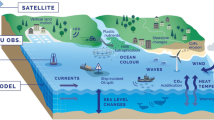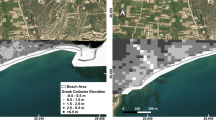Abstract
This article aims to provide a tour of satellite missions for Coastal Hazards Monitoring, of relevant applications, as well as the downstream International Services such as the Copernicus Ocean and Land Monitoring Services. Earth observation (EO) satellite remote sensing provides global, repetitive and long-term observations with increasing resolution with every new generation of sensors. They permit the monitoring of small-scale signals like the ones impacting the coastal zone. EO missions are showcased in this article. Transforming the data products based on the satellite mission ground segment (usually called geophysical products, geophysical data records or so-called Level 2 products) into information useable by managers and decision-makers is done by downstream international services. This is an essential step to increase the uptake of satellite data for the benefit of society. Here, the type of services provided by, e.g., the European Copernicus Programme, is described along with examples of applications, such as monitoring storm surges.

Credit: ESA

Credit: ESA

Credit: ESA

Credit: ESA

The image contains modified Copernicus Sentinel data (2017), processed by ESA, CC BY-SA 3.0 IGO

Contains modified Copernicus Sentinel data (2017), processed by ESA, CC BY-SA 3.0 IGO


Credits: ESA, LEGOS, CLS, CNES, and CMEMS—Assembled at LEGOS

Source: ESA Sea_Level_cci Project

Source: GlobWave, SatOC

Source: Copernicus, Météo-France, L. Aouf


Credits: ESA

Credits: ESA, CNR, e-Surge-Venice Project

Credits: ESA, the image contains modified Copernicus Sentinel data (2020), processed by ESA, CC BY-SA 3.0 IGO
Similar content being viewed by others
References
Abulaitijiang A, Andersen OB, Stenseng L (2015) Coastal sea level from inland CryoSat-2 interferometric SAR altimetry. Geophys Res Lett 42:1841–1847. https://doi.org/10.1002/2015GL063131
Bajo M, De Biasio F, Umgiesser G, Vignudelli S, Zecchetto S (2017) Impact of using scatterometer and altimeter data on storm surge forecasting. Ocean Model 113:85–94. https://doi.org/10.1016/j.ocemod.2017.03.014
Benveniste J et al (2019) Requirements for a coastal hazards observing system. Front Mar Sci 6:348. https://doi.org/10.3389/fmars.2019.00348
Biermann L, Clewley D, Martinez-Vicente V et al (2020) Finding plastic patches in coastal waters using optical satellite data. Sci Rep 10:5364. https://doi.org/10.1038/s41598-020-62298-z
Birol F, Fuller NX, Lyard F et al (2017) Coastal applications from nadir altimetry: example of the X-TRACK regional products. Adv Space Res 59:936–953. https://doi.org/10.1016/j.asr.2016.11.005
Cazenave A, Le Cozannet G (2014) Sea level rise and coastal impacts. Earth’s Fut 2(2):15–34. https://doi.org/10.1002/2013EF000188
Cipollini P, Benveniste J, Birol F et al (2018) Satellite altimetry in coastal regions. In: Stammer D, Cazenave A (eds) Satellite altimetry over the oceans and land surfaces. CRC Press, Taylor and Francis Group, Boca Raton, London, New York, pp 343–373. https://doi.org/10.1201/9781315151779-11
De Biasio F, Bajo M, Vignudelli S, Umgiesser G, Zecchetto S (2017) Improvements of storm surge forecasting in the Gulf of Venice exploiting the potential of satellite data: the ESA DUE eSurge-Venice project. Eur J Remote Sens 50:428–441. https://doi.org/10.1080/22797254.2017.1350558
DeConto RM, Pollard D (2016) Contribution of Antarctica to past and future sea-level rise. Nature 531:591–597
GCOS (2016) The global observing system for climate: implementation needs. Technical report GCOS-200, World Meteorological Organization
Gouzenes Y, Léger F, Cazenave A, Birol F, Bonnefond P, Passaro M, Nino F, Almar R, Laurain O, Schwatke C, Legeais J-F, Benveniste J (2020) Coastal sea level rise at Senetosa (Corsica) during the Jason altimetry missions. Ocean Sci Discuss. https://doi.org/10.5194/os-2020-3
Hughes CW, Thompson K, Minobe S, Fukumori I, Griffies S, Huthnance J, Spence P (2019) Sea level and the role of coastal-trapped waves in mediating the interaction between the coast and open ocean. Surv Geophys. https://doi.org/10.1007/s10712-019-09535-x
Idžanović M, Ophaug V, Andersen OB (2017) Coastal sea level from CryoSat-2 SARIn altimetry in Norway. Adv Space Res 62:1344–1357. https://doi.org/10.1016/j.asr.2017.07.043
Jansen E, Pimentel S, Tse W-H, Denaxa D, Korres G, Mirouze I, Storto A (2019) Using Canonical Correlation Analysis to produce dynamically-based highly-efficient statistical observation operators. Ocean Sci Discuss. https://doi.org/10.5194/os-2018-166
Kopp RE et al (2017) Evolving understanding of antarctic ice-sheet physics and ambiguity in probabilistic sea-level projections. Earth’s Fut 5:1217–1233. https://doi.org/10.1002/2017EF000663
Kulp SA, Strauss BH (2019) New elevation data triple estimates of global vulnerability to sea-level rise and coastal flooding. Nat Commun 10:4844. https://doi.org/10.1038/s41467-019-12808-z
Le Bars D, Drijfhout S, de Vries H (2017) A high-end sea level rise probabilistic projection including rapid Antarctic ice sheet mass loss. Environ Res Lett 12:044013. https://doi.org/10.1088/1748-9326/aa6512
Le Traon P-Y et al (2019) From observation to information and users: the Copernicus Marine Service perspective. Frontiers in Marine Science, Oceanobs’19 Community White Paper. https://doi.org/10.3389/fmars.2019.00234
Legeais J-F, Ablain M, Zawadzki L, Zuo H, Johannessen JA, Scharffenberg MG, Fenoglio-Marc L, Fernandes MJ, Andersen OB, Rudenko S, Cipollini P, Quartly GD, Passaro M, Cazenave A, Benveniste J (2018) An improved and homogeneous altimeter sea level record from the ESA Climate Change Initiative. Earth Syst Sci Data 10:281–301. https://doi.org/10.5194/essd-10-281-2018
Madsen KS, Høyer JL, Fu W, Donlon C (2015) Blending of satellite and tide gauge sea level observations and its assimilation in a storm surge model of the North Sea and Baltic Sea. J Geophys Res 120(9):6405–6418. https://doi.org/10.1002/2015JC011070
Maximenko N et al (2019) Toward the integrated marine debris observing system. Front Mar Sci 6:447. https://doi.org/10.3389/fmars.2019.00447
Melet A, Teatini P, Le Cozannet G, Jamet C, Conversi A, Benveniste J, Almar R (2020) Earth observations for monitoring marine coastal hazards and their drivers. Surv Geophys. https://doi.org/10.1007/s10712-020-09594-5
Nerem RS, Beckley BD, Fasullo JT, Hamlington BD, Masters D, Mitchum GT (2018) Climate-change-driven accelerated sea-level rise detected in the altimeter era. PNAS 115(9):2022–2025. https://doi.org/10.1073/pnas.1717312115
Nicholls RJ, Cazenave A (2010) Sea level change and the impacts in coastal zones. Science 328:1517–1520. https://doi.org/10.1126/science.1185782
Oppenheimer M, Glavovic BC, Hinkel J, van de Wal R, Magnan AK, Abd-Elgawad A, Cai R, Cifuentes-Jara M, DeConto RM, Ghosh T, Hay J, Isla F, Marzeion B, Meyssignac B, Sebesvari Z (2019) Sea level rise and implications for low-lying islands, coasts and communities. In: Pörtner H-O, Roberts DC, Masson-Delmotte V, Zhai P, Tignor M, Poloczanska E, Mintenbeck K, Alegría A, Nicolai M, Okem A, Petzold J, Rama B, Weyer NM (eds) IPCC special report on the ocean and cryosphere in a changing climate. Available at https://www.ipcc.ch/srocc/
Sathyendranath S, Brewin RJW, Brockmann C, Brotas V, Calton B, Chuprin A, Cipollini P, Couto A, Dingle J, Doerffer R, Donlon C, Dowell M, Farman A, Grant MG, Groom S, Horseman A, Jackson T, Krasemann H, Lavender S, Martinez-Vicente V, Mazeran C, Mélin F, Moore T, Müller D, Regner P, Roy S, Steele C, Steinmetz F, Swinton J, Taberner M, Thompson A, Valente A, Zühlke M, Brando V, Feng H, Feldman G, Franz B, Frouin R, Gould R, Hooker S, Kahru M, Kratzer S, Mitchell B, Muller-Karger F, Sosik H, Voss K, Werdell J, Platt T (2019) An ocean-colour time series for use in climate studies: the experience of the ocean-colour climate change initiative (OC-CCI). Sensors 19(19):4285. https://doi.org/10.3390/s19194285
Shepherd A, Ivins E, Rignot E et al (2020) Mass balance of the Greenland Ice Sheet from 1992 to 2018. Nature 579:233–239. https://doi.org/10.1038/s41586-019-1855-2
Sherwood CR, Book JW, Carniel S, Cavaleri L, Chiggiato J, Das H, Doyle JD, Harris CK, Niedoroda AW, Perkins H (2004) Sediment dynamics in the adriatic sea investigated with coupled models. Oceanography 17:58–69. https://doi.org/10.5670/oceanog.2004.04
Short AD (2020) The Australian coast: review and overview. In: Australian coastal systems. Coastal Research Library, vol 32, Springer, Cham. https://doi.org/10.1007/978-3-030-14294-0_34
Vousdoukas M, Mentaschi L, Voukouvalas E, Bianchi A, Dottori F, Feyen L (2018) Climatic and socioeconomic controls of future coastal flood risk in Europe. Nat Clim Change 8:776–780. https://doi.org/10.1038/s41558-018-0260-4
WCRP Global Sea Level Budget Group (The) (2018) Global sea level budget, 1993-present. Earth Syst Sci Data 10:1551–1590. https://doi.org/10.5194/essd-10-1551-2018
Williams J, Hughes CW (2013) The coherence of small island sea level with the wider ocean: a model study. Ocean Sci 9:111–119. https://doi.org/10.5194/os-9-111-2013
Wong TE, Bakker AM, Keller K (2017) Impacts of Antarctic fast dynamics on sea-level projections and coastal flood defense. Clim Change 144:347–364. https://doi.org/10.1007/s10584-017-2039-4
Woodworth P, Melet A, Marcos M, Ray RD, Wöppelmann G, Sasaki YN, Cirano M, Hibbert A, Huthnance JM, Montserrat S, Merrifield MA (2019) Forcing factors affecting sea level changes at the coast. Surv Geophys 40:1351–1397. https://doi.org/10.1007/s10712-019-09531-1
Acknowledgements
This article is an outcome of the International Space Science Institute workshop on “Natural and man-made hazards monitoring by the Earth Observation missions: current status and scientific gaps” held at the ISSI-Bern, Switzerland, on 15–18 April 2019. Warm thanks are extended to the International Space Science Institute and to Dr Teodolina Lopez and Dr Anny Cazenave for the organisation. We are also grateful to the reviewers for their appreciated contributions to improve the manuscript.
Author information
Authors and Affiliations
Corresponding author
Additional information
Publisher's Note
Springer Nature remains neutral with regard to jurisdictional claims in published maps and institutional affiliations.
Rights and permissions
About this article
Cite this article
Benveniste, J., Mandea, M., Melet, A. et al. Earth Observations for Coastal Hazards Monitoring and International Services: A European Perspective. Surv Geophys 41, 1185–1208 (2020). https://doi.org/10.1007/s10712-020-09612-6
Received:
Accepted:
Published:
Issue Date:
DOI: https://doi.org/10.1007/s10712-020-09612-6




